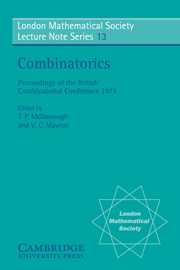Book contents
- Frontmatter
- Contents
- Preface
- Papers contributed by the participants
- Perfect codes and distance-transitive graphs
- Generalisation of Fisher's inequality to fields with more than one element
- On balanced arrays
- Positions in Room squares
- Analogues of Heawood's theorem
- Cut-set lattices of graphs
- On the chromatic index of a graph, II.
- On a theorem of R. A. Liebler
- Outerthickness and outercoarseness of graphs
- Graphs with homeomorphically irreducible spanning trees
- A note on embedding latin rectangles
- Some results in semi-stable graphs
- Hereditary properties and P-chromatic numbers
- Some problems concerning complete latin squares
- Necklace enumeration with adjacency restrictions
- On a family of planar bicritical graphs
- On the enumeration of partially ordered sets of integers
- The distance between nodes in recursive trees
- Partition relations
- On a problem of Daykin concerning intersecting families of sets
- Unstable trees
- Distance-transitive graphs
- Enumeration of graphs on a large periodic lattice
- Some polynomials associated with graphs
- Equidistant point sets
- Eigenvalues of graphs and operations
- Graph theory and algebraic topology
- Applications of polymatroids and linear programming to transversals and graphs
- Problem section
Graphs with homeomorphically irreducible spanning trees
Published online by Cambridge University Press: 05 April 2013
- Frontmatter
- Contents
- Preface
- Papers contributed by the participants
- Perfect codes and distance-transitive graphs
- Generalisation of Fisher's inequality to fields with more than one element
- On balanced arrays
- Positions in Room squares
- Analogues of Heawood's theorem
- Cut-set lattices of graphs
- On the chromatic index of a graph, II.
- On a theorem of R. A. Liebler
- Outerthickness and outercoarseness of graphs
- Graphs with homeomorphically irreducible spanning trees
- A note on embedding latin rectangles
- Some results in semi-stable graphs
- Hereditary properties and P-chromatic numbers
- Some problems concerning complete latin squares
- Necklace enumeration with adjacency restrictions
- On a family of planar bicritical graphs
- On the enumeration of partially ordered sets of integers
- The distance between nodes in recursive trees
- Partition relations
- On a problem of Daykin concerning intersecting families of sets
- Unstable trees
- Distance-transitive graphs
- Enumeration of graphs on a large periodic lattice
- Some polynomials associated with graphs
- Equidistant point sets
- Eigenvalues of graphs and operations
- Graph theory and algebraic topology
- Applications of polymatroids and linear programming to transversals and graphs
- Problem section
Summary
By a graph G we mean here a linear network, at least 3-connected with no vertices of degree 2, no multiple edges and no loops. A graph T is called a spanning graph of G provided (i) T is a tree, (ii) T is a subgraph of G and (iii) every vertex of G belongs to T.
A graph is said to be homeomorphically irreducible (HI) if it has no nodes of degree 2. Thus an HI tree may be a spanning tree of G and we shall call this graph a HISTree of G.
Starting with the example of the set of all 3-polytopes, inspection shows that while all possess spanning trees [1] not all have HISTrees.(1) We would like to know which graphs possess HISTrees, if such graphs are common and what may be found as contingent with the existence or non-existence of this feature.
Types of HISTrees
For the purpose of the present note it is sufficient to regard these graphs as belonging to three main sub-species. These are:
(i) Stars (as in fig. 4, which shows the smallest).
(ii) Star chains (as in figs. 5, 6. 1 and 10. 1).
(iii) Star trees (as in fig. 7.1).
Types of 3-polytopes with HISTrees
The most obvious example of a family of graphs G containing a HISTree is the family of those 3-polytopes in which those edges not belonging to the HISTree comprise a circuit joining the terminal vertices of the HISTree.
- Type
- Chapter
- Information
- Combinatorics , pp. 61 - 68Publisher: Cambridge University PressPrint publication year: 1974
- 5
- Cited by

